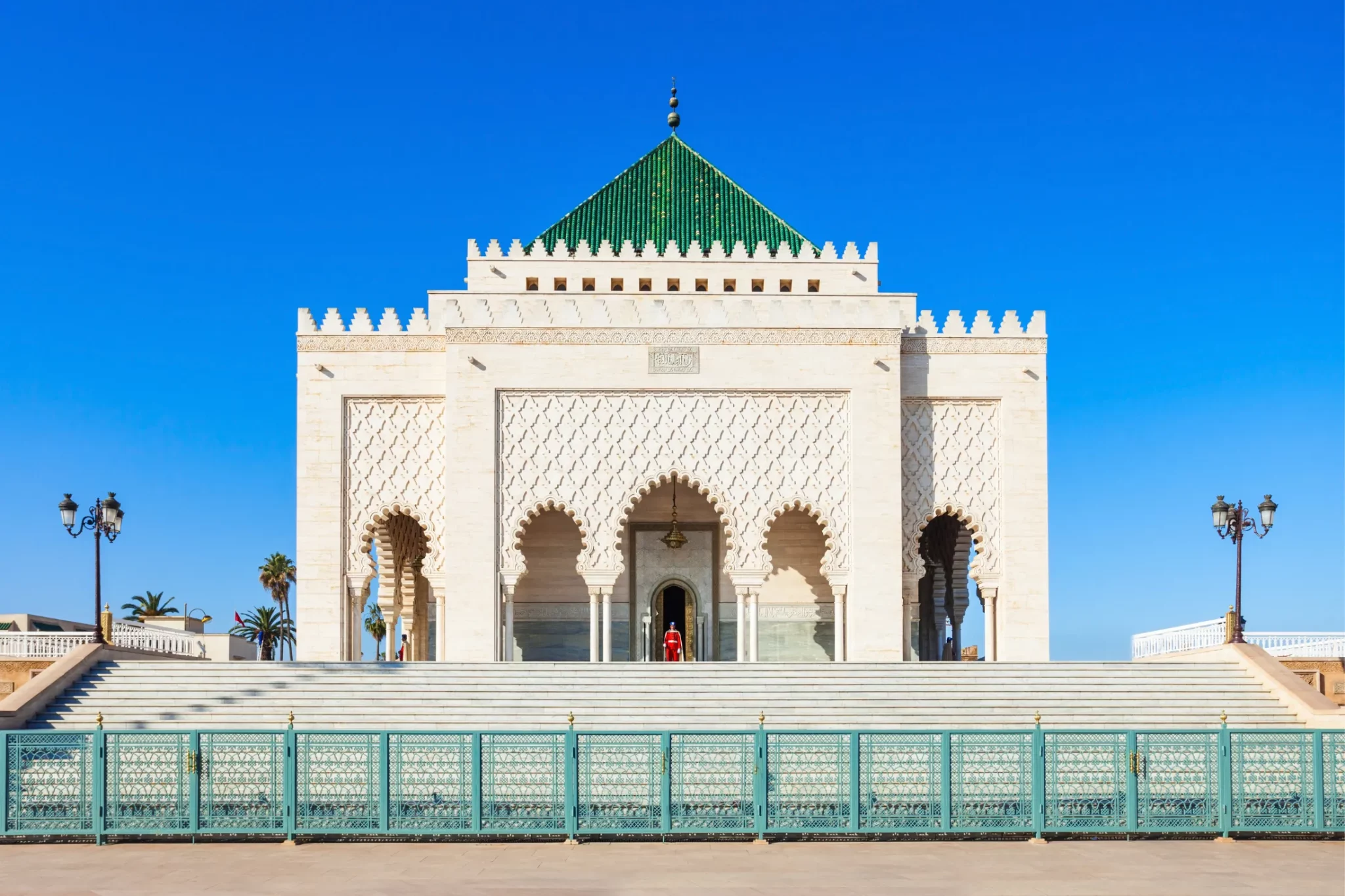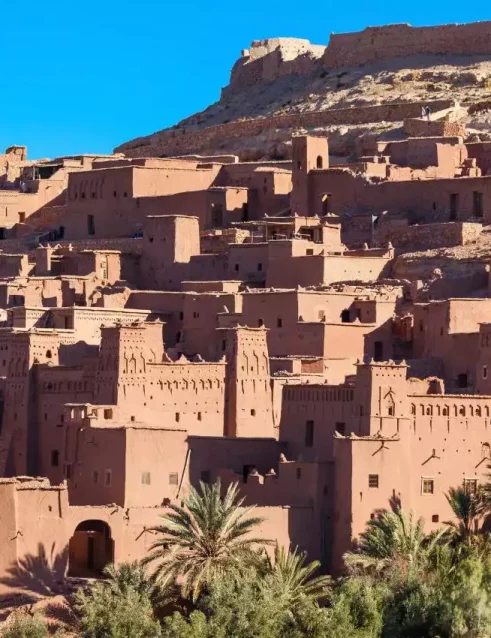Top 5 Things to Do In Rabat

Visit the Mausoleum of Mohammed V
One of the most significant historical sites in Rabat, the Mausoleum of Mohammed V, is a must-visit. Positioned across from the iconic Hassan Tower, the mausoleum is the final resting place of King Mohammed V and his two sons, King Hassan II and Prince Abdallah.
King Mohammed V passed away in 1961, prompting his son, Hassan II, to commission the construction of this grand mausoleum. The building was designed by Vietnamese architect Cong Vo Toan, combining traditional designs with modern materials. The use of rich materials and the careful incorporation of historical crafts and motifs were meant to pay tribute to Mohammed V’s efforts to encourage traditional craftsmanship, thereby promoting a sense of Moroccan identity.
The process of building the mausoleum began in 1961, which included refurbishment efforts for the esplanade of the old mosque from the Almohad era, where the Hassan Tower is located. It was completed a decade later in 1971. The same year, Mohammed V’s body was transferred to this site. His son, Abdallah, was buried here in 1983, followed by Hassan II in 1999.
The mausoleum, sitting on an elevated platform, is a rectangular structure built with reinforced concrete and covered in white marble. The exterior is defined by Moorish arches and a pyramidal green roof, while the interior is marked with mahogany wood dome and zellij tiling on the walls. Some elements are finished with chased brass, creating an elegant aesthetic.
Across the mausoleum, a rectangular open-air pavilion housing a museum for the Alaouite dynasty can be found. It is accompanied by a mosque built as part of the complex. The mosque is situated at a lower level to not obstruct the view of the mausoleum and the museum.
Visiting the Mausoleum of Mohammed V provides an insightful look into Morocco’s history and the legacy of its royal family. The impressive architecture and the serene environment make it an unmissable experience when in Rabat.

Attend a Cooking Class
There’s no better way to immerse yourself in a country’s culture than through its cuisine. In Rabat, joining a cooking class allows you to do just that. In these classes, locals with years of culinary experience guide you in preparing authentic Moroccan dishes. Whether it’s a family who’ve honed their cooking skills through generations or a professional chef with decades of experience, you’re sure to learn valuable culinary techniques and traditional recipes.
One of the dishes you’ll often come across in these cooking classes is the famous Moroccan tagine. Named after the unique earthenware pot it’s cooked in, tagine is a slow-cooked stew that combines meat, poultry, fish, vegetables, and fruit with a rich array of spices. The tagine’s distinct sweet and sour flavor profiles make it a centerpiece in Moroccan cuisine.
If you have a sweet tooth, you might enjoy learning to make briouat, a small pastry often filled with meat, cheese, onions, and various herbs and spices. If you prefer something sweeter, the almond briouats, coated in warm honey and filled with almond paste, could be your delight.
A staple in Moroccan cuisine that’s also commonly featured in these cooking classes is couscous, small granules of durum wheat semolina. Couscous is traditionally served with a meat or vegetable stew spooned on top, making it a communal affair enjoyed by all around the table.
Another interesting dish that might feature in your cooking class is shakshuka, a popular breakfast dish of poached eggs cooked in a tomato sauce with peppers, garlic, onions, olive oil, and spices.
Finally, you could learn to prepare harira, a tomato-based lentil and chickpea soup, often served to break the fast during Ramadan.
Overall, joining a cooking class in Rabat not only allows you to learn and prepare authentic Moroccan recipes but also offers an insight into the Moroccan way of life. It’s a delightful experience, whether you’re a seasoned cook or a novice in the kitchen.

Visit one of many museums in Rabat
A museum visit is a wonderful way to understand history and culture. In Rabat, Morocco, there are many museums you can visit.
One of them is the National Archaeology Museum. It is in the center of Rabat. You can see items found from many places like Banassa and Volubilis. The items in the museum tell the story of Morocco from very old times to the Islamic era. You can see weapons from prehistoric times and Roman statues. A special item to see is the bronze busts of Juba II and Cato the Younger. You can visit this museum from 09:00 to 16:00 every day, but it is closed on Tuesday.
Another museum is The Currency Museum of the Bank Al-Maghrib. This museum tells the story of money in Morocco. It has over 30,000 items. This includes coins and banknotes. The museum also has an art gallery with 80 works of art. There is also an area where you can learn about the history of Bank Al-Maghrib.
The Musée de Maroc Telecom is also an important place to visit. This museum shows the history of telecommunications in Morocco. It is the first technical museum in the country.
Finally, there is the Oudaia Museum. This museum is in an old fort. The museum has many items from the Islamic period. You can see silver and gold-plated jewelry from many parts of Morocco. The museum also has ceramics from the 19th and early 20th centuries. There are also collections of gold ornaments.
Each of these museums offers a unique look into the history and culture of Morocco. They are worth a visit for anyone interested in learning more about this fascinating country.

Visit Kasbah of the Udayas
Number 4 on our list is a visit to the Kasbah of the Udayas, a part of the UNESCO World Heritage Sites. It stands on a hill near the Bou Regreg river. The Medina quarter of Rabat is nearby.
The name ‘Kasbah of the Udayas’ comes from the word ‘wadi’, meaning ‘river valley’. The Kasbah has a rich history. It started as a fortified outpost in the 10th century, built by the Umayyads of Cordoba. Over time, rulers built new structures over the original one. The Almohad caliph, Abd al-Mu’min, built a palace and a mosque within the Kasbah. During the time of the Marinid era, the town of Salé, which is located across the river, became more important and was developed.
In the 17th century, refugees from Spain settled around Salé and occupied the Kasbah. They established a republic, known as the Republic of Salé. It served as a base for pirates, known as the ‘Salé Rovers’. They preyed on merchant ships around the shores of Western Europe. This era saw several constructions within the Kasbah, such as a broad platform used for semaphore signalling.
Sultan Moulay Ismail built a palace in the Kasbah in the 17th century, which is now a museum. This is the same museum we mentioned above. The Kasbah of the Udayas got its name in the 19th century after a tribe called Udayas settled in the Kasbah.
The Kasbah of the Udayas became a UNESCO World Heritage Site in 2012. The Kasbah has several structures and monuments, such as the Great Gate of the Kasbah, the Old Mosque, and the Oudayas Museum. The Old Mosque is the oldest structure in the Kasbah. It was built in 1150 and later restored in the 18th century.
The Oudayas Museum, located in the southern part of the Kasbah, is where visitors can find the previously mentioned museum. It was a palace built by Sultan Moulay Ismail. It later served as a school. The museum displays various items from different parts of the country, such as jewellery, musical instruments, ceramics, Qur’ans and manuscripts, costumes, silks, and carpets.
In summary, the Kasbah of the Udayas is a must-visit place because of its rich history and cultural significance. It offers visitors a glimpse into the historical events that shaped Morocco and a chance to appreciate its diverse heritage.

Steeped in rich history, Rabat is not only the capital of Morocco but also a treasure trove of cultural experiences and exciting shopping opportunities. From winding ancient streets laden with traditional craft stores to the gleaming modern shopping centers, there’s something for everyone.
To experience traditional Moroccan shopping, a visit to the Medina of Rabat is essential. The Medina, which predates the French expansion of the city in 1912, is a testament to the Andalusian Muslim refugees who founded it. It is bustling with traditional shops and cafes that add to the unique ambience of the city.
As you stroll through the Medina, look out for the leather footwear bazaars, Moroccan craft shops, and curiosity stores. Here, you will find everything from hand-embroidered fabrics, intricate Berber carpets, antique items, and copperware to unique souvenirs and trinkets. Be sure to explore stalls on Green Street that sell mentha leaves for making Moroccan tea, a cheap and local favorite.
Another must visit spot is Rue des Consuls, a historic street that has been the heart of Rabat for over 500 years. Once a residence for numerous ambassadors and consuls, it has now become a landmark craft souk that attracts tourists with its wide array of traditional carpets, jewelry, leather goods, and local attire.
Souk es-Sabat is a famous shopping destination, known for shoes, leather, and jewelry. You will also find traditional babouches, musical instruments, and many other interesting items that perfectly capture the spirit of Moroccan culture.
Rue Souika is another must-visit shopping spot. It offers a rich blend of vibrant local colors and a myriad of shopping options from clothing, shoes, jewelry, carpets, crafts, to pottery. Wandering around Rue Souika also provides a glimpse into everyday life in Rabat.
For foodies and lovers of fresh produce, Marché Central is a treat. Established in the 1920s, it is a popular destination for both locals and tourists. The market boasts an extensive range of food, fruits, meat, fish, and other local food specialties, alongside a beautiful selection of flowers.
For a modern shopping experience, Rabat boasts some exceptional shopping centers.
One of the most famous is the Mega Mall, which is one of the largest shopping centers in Morocco. From a wide range of international brands in clothing, shoes, watches, jewelry, furniture, and electronic appliances to entertainment facilities like an ice rink, bowling alley, and a 5D cinema complex, the Mega Mall offers a comprehensive and exciting shopping experience.
The Ryad Square Shopping Center, with its expansive three levels of diverse shops, is another popular destination in Rabat. Whether you’re looking for clothes, accessories, sports equipment, or cosmetics, the Ryad Square Shopping Center has something for everyone. It also features a variety of restaurants and cafes, ensuring that your shopping trip is punctuated with delightful gastronomic experiences.
Whether you’re a history enthusiast looking to delve into the vibrant past of Rabat or a shopper looking for both traditional and modern goods, Rabat promises a unique and fulfilling shopping experience that is hard to forget.
Our top 5 things to do in Rabat list showcases the incredible diversity that the city has to offer. From the historical richness of the Mausoleum of Mohammed V and the Kasbah of the Udayas, to the modern delights of shopping in Rabat’s contemporary malls, the capital city provides a captivating blend of the old and the new. Rabat truly provides a unique experience. It gracefully combines its historical roots and modern innovations, offering its visitors a wide range of activities that few other cities can match. So come, explore, and let Rabat reveal its magic to you.










